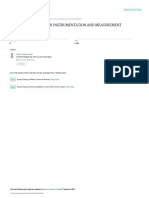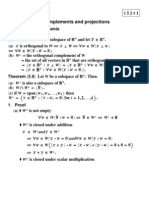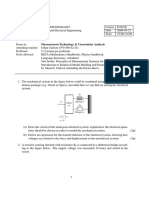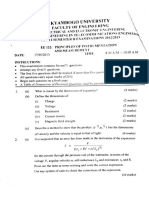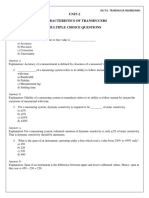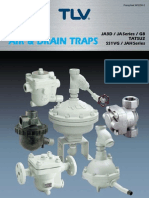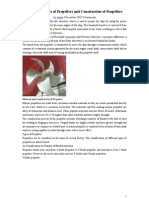Tutorial
Uploaded by
Sivanesh KumarTutorial
Uploaded by
Sivanesh KumarEME 2066 Measurement and Instrumentation, Trim.
3, 2014-2015
Tutorial 1
*To be worked out by tutor in Tutorial class.
The remaining problems to be worked out by students in tutorial hours individually for submission
(hand written only) at the end of Tut. class (Max. 0.5 towards assignment mark). If they cannot
complete, they can do as homework and submit the next day (Max.0.4 towards assignment mark).
The students can work out some of the problems before attending the tutorial class in order to
complete all problems and submit at the end of Tut. Class.
Each student is required to submit individually a hand-written tutorial (all problems)solution
report to the respective Tutor only.
1.
*A temperature sensor operating as a first order system has a time constant of 0.1 s. If it is
initially at a temperature of 100oC and is suddenly exposed to an environment with a
temperature of 15C,how long will it take to indicate a temperature of 17C ?If this
temperature sensor is exposed to a harmonic temperature source, for what frequency range,
will its amplitude response be within 1 0.1? What will be the time delay under these
circumstances?
(0.375 s, up to 4.84 rad/s,0.093 s )
2.
A thermometer has a time constant of 10s and behaves as a first order system.It is initially
at a temperature 30oC and then suddenly subjected to a surrounding temperature of 120oC.
Calculate the 90% rise time and the time taken to attain 99% of the steady-state emperature.
Draw a graph showing the variation of temperature with time and indicate the salient points.
(23.03 s; 43.17 s)
*A 2g mass is suspended from a simple spring. The deflection caused by this mass is
0.5cm. Develop the equation governing the behaviour of this system and find the natural
frequency of the system.
(7.05 Hz)
3.
4.
A sinusoidal forcing function is impressed on the system in Fig. Q4. The natural frequency
is 100 Hz, and the damping ration c/cc is 0.7, Calculate the amplitude ratio and time lag of
the system for an input frequency of 40 Hz. (The time lag is the time interval between the
maximum force input and maximum displacement output)
(0.9905 ,0.00234 s)
F (t) =F0 sin t
Fig. Q4
5.
For a natural frequency of 100 Hz and a damping ratio of 0.7, compute the input frequency
for which the system in Fig. Q4 will have an amplitude ratio of 1.000.01.
(40.48 Hz)
6.
*A pressure transducer operates as a second-order system having a natural frequency of 10
kHz. For damping ratio (c/cc) of 0.4, determine the resonant frequency. Determine the
amplitude ratio and phase shift at a frequency of 3200 Hz.
(8000 Hz, 1.0713, -17.6)
7.
A certain resistor draws 5.3 A when a voltage of 110.2 V is applied. The uncertainties in the
measurement of voltage and current are 0.2V and 0.06A, respectively. Calculate the
power dissipated in the resistor and the uncertainty in the power calculated.
(584.06 watts, 1.146%)
*Two resistors R1 and R2 are connected in series and parallel. The values of the resistances
are:
R1=100.0 0.1
R2=50.0 0.03
Calculate the uncertainty in the combined resistance for both the series and the parallel
arrangements.
(0.1044 , 0.01735)
8.
EME 2066 Measurement and Instrumentation, Trim.3, 2014-2015
9.
Four resistors having nominal values of 1,1. 5,3 and 2.5 k are connected in parallel. The
uncertainty in the value of each resistor is 10 %.A voltage of 100V 1.0 V is impressed on
the combination. Calculate the power drawn and its uncertainty.
(24 W, 5.41 %)
10. *The following heat transfer data points are expected to follow a functional form of N = aRb
Obtain values of a and b from a graphical analysis and also by the method of least
squares.
R 12 20 30 40 100 300 400 1000 3000
N 2 2.5 3 3.3 5.3 10 11 17
30
(a=0.5465; b=0.4894)
11. The following data are expected to follow a linear relation of the form y = mx +c. Obtain the
best linear relation in accordance with a least-squares analysis.
x
y
0.9
1.1
2.3
1.6
3.3
2.6
4.5
3.2
5.7
4.0
6.7
5.0
( y=0 .
6721x+0.2955)
REVIEW QUESTIONS -CHAPTER 1
( the students are strongly advised to find answers for these questions themselves from the text
book/ref. book to ensure that they have understood important points in the contents of the
Chapter, No need to submit answers).
1. What is meant by (a) sensitivity (b) accuracy (c) precision?
2. Why is instrument calibration necessary?
3. What is the difference between static and dynamic measurements?
4. Why are standards necessary?
5. What is meant by frequency response?
6. Describe the meaning of phase shift. Comment on the phase shift in zero-,first- and second order systems subjected to a
forcing function which is i) step ii) sinusoidal
7. Define time constant and rise time.
8. What kind of impedance matching is desired for (a) maximum power transmission and (b) minimum influence on the output
of the system?
9. What is meant by time delay of steady state response?
10. What is meant by zero- , first- and second- order systems?
11. What is meant by steady state response and transient response? Give example.
12. Pressure is measured in units of lbf /in2 in the English system of units. Derive factors to convert to units of N/m2 (Pa).
13. What factors influence the time constant in first-order systems?
14. How does an error differ from an uncertainty?
15. What is the difference between fixed error and random error?
16. Define standard deviation and variance?
17. What is meant by linear frequency response?
18. What is meant by distortion? What are the reasons for distortion?
19. What is meant by measure of precision?
20. What is meant by gross experimental errors? Give example.
21. What is meant by systematic/bias experimental error? Give Examples.
22. How can gross experimental errors be reduced?
23. What are the causes of instrument errors? How can they be reduced?
24. What is meant by environmental errors? How can be reduced?
25. Explain what is meant by observational errors and how they can be reduced.
26. What are some purposes of uncertainty analyses?
27. Why is uncertainty analysis important in the preliminary stages of experiment
planning ?
EME 2066 Measurement and Instrumentation, Trim.3, 2014-2015
28. How can an uncertainty analysis help to reduce overall experimental uncertainty?
29. What is meant by standard deviation of the mean?
30. What is a least squares analysis? How is it useful?
31. What is meant by correlation coefficient? What does it mean when the correlation coefficient is 1.0?
32. What is meant by regression analysis?
33. Why should one always make a graphical plot of data?
34. Draw the block diagram of generalised measurement system and explain the function of each block.
You might also like
- Practice Problems For Instrumentation and MeasurementNo ratings yetPractice Problems For Instrumentation and Measurement13 pages
- Does A Smaller Diameter Thermocouple or A Larger Diameter Thermocouple Have The Large Time ConstantNo ratings yetDoes A Smaller Diameter Thermocouple or A Larger Diameter Thermocouple Have The Large Time Constant2 pages
- 5.2 Orthogonal Complements and ProjectionsNo ratings yet5.2 Orthogonal Complements and Projections17 pages
- Sheet (5) (Dynamic Characteristics of Instrument Systems)No ratings yetSheet (5) (Dynamic Characteristics of Instrument Systems)7 pages
- Principles of Instrumentation and Measurement Year 1 Sem 2No ratings yetPrinciples of Instrumentation and Measurement Year 1 Sem 28 pages
- Instrumentation and Control Assignment - I MMENo ratings yetInstrumentation and Control Assignment - I MME3 pages
- Material Science Spring 2017 Exam 1 - KeyNo ratings yetMaterial Science Spring 2017 Exam 1 - Key8 pages
- Material Science Fall 2016 Exam 1 SolutionNo ratings yetMaterial Science Fall 2016 Exam 1 Solution9 pages
- Exam - Measurement Technique, ELA210, TEN1, 2023-12-08: Please Read These Instructions Carefully!No ratings yetExam - Measurement Technique, ELA210, TEN1, 2023-12-08: Please Read These Instructions Carefully!5 pages
- MTExam1 Engineering Metrology & Measurements 2022 2023No ratings yetMTExam1 Engineering Metrology & Measurements 2022 20235 pages
- Assignment Sheet 1 Mechanical Measurements and Instrumentation Due Date On or Before 16/09/2014 Problems Based On Chap 3 - DynamiccharactersticsNo ratings yetAssignment Sheet 1 Mechanical Measurements and Instrumentation Due Date On or Before 16/09/2014 Problems Based On Chap 3 - Dynamiccharacterstics3 pages
- Instrumentation and Measurement (Meng3204) - Assignment 1: Dynamic Response of Measurement SystemNo ratings yetInstrumentation and Measurement (Meng3204) - Assignment 1: Dynamic Response of Measurement System1 page
- Instrumentation and Measurement (Meng3204) - Assignment 1: Dynamic Response of Measurement SystemNo ratings yetInstrumentation and Measurement (Meng3204) - Assignment 1: Dynamic Response of Measurement System1 page
- X X X FX X: ...... 3! 5! 7! Cos Sin SinhNo ratings yetX X X FX X: ...... 3! 5! 7! Cos Sin Sinh12 pages
- PART-A (30 Marks) Time: 60 Minutes Solve The Following QuestionsNo ratings yetPART-A (30 Marks) Time: 60 Minutes Solve The Following Questions3 pages
- Computer Assignment No 04: Matlab/Pspice SimulationNo ratings yetComputer Assignment No 04: Matlab/Pspice Simulation35 pages
- EEE312 Measurments and Instrumentation - END - Exam PaperNo ratings yetEEE312 Measurments and Instrumentation - END - Exam Paper5 pages
- Assignment 1 - Engineering Measurement-Anandababu NNo ratings yetAssignment 1 - Engineering Measurement-Anandababu N14 pages
- Slot: TD2 Faculty: Dr. Sakthi Swarrup J Answer ALL The Questions 1.No ratings yetSlot: TD2 Faculty: Dr. Sakthi Swarrup J Answer ALL The Questions 1.2 pages
- Measurements and Instrumentation (ELE 3202) (Makeup)No ratings yetMeasurements and Instrumentation (ELE 3202) (Makeup)3 pages
- MTExam1 Engineering Metrology & Measurements 2022 2023No ratings yetMTExam1 Engineering Metrology & Measurements 2022 20235 pages
- Phy 107 & 108 General Physics Laboratory I & Ii-1-1No ratings yetPhy 107 & 108 General Physics Laboratory I & Ii-1-14 pages
- Spectral method for fatigue damage estimation with non-zero mean stressFrom EverandSpectral method for fatigue damage estimation with non-zero mean stressNo ratings yet
- Lecture 2 Characteristics and Type ResearchNo ratings yetLecture 2 Characteristics and Type Research25 pages
- Eme4016 Heat Transfer Trimester 2, 2016-2017 Assignment Group NumbersNo ratings yetEme4016 Heat Transfer Trimester 2, 2016-2017 Assignment Group Numbers4 pages
- Epoxy Resins: Manufacturing Process of With Formulation100% (1)Epoxy Resins: Manufacturing Process of With Formulation48 pages
- Tutorial 1 EME 3056 Industrial ManagementNo ratings yetTutorial 1 EME 3056 Industrial Management4 pages
- Practical Examination Time-Table-B.Sc. Semester-I-2024-25No ratings yetPractical Examination Time-Table-B.Sc. Semester-I-2024-252 pages
- More Accurate Localized Wire Rope Testing Based On Hall Sensor ArrayNo ratings yetMore Accurate Localized Wire Rope Testing Based On Hall Sensor Array2 pages
- Piles Bearing Capacity - Calculations - 1No ratings yetPiles Bearing Capacity - Calculations - 11 page
- The Point of These Exercises Is To Make You Familiar With All The BasicsNo ratings yetThe Point of These Exercises Is To Make You Familiar With All The Basics21 pages
- Duffing Oscillator Report by Sam Needham at ANUNo ratings yetDuffing Oscillator Report by Sam Needham at ANU20 pages
- Barchip Technical Note: Best Practice For Testing Fibre Reinforced ShotcreteNo ratings yetBarchip Technical Note: Best Practice For Testing Fibre Reinforced Shotcrete12 pages
- Voltage Standing Wave Ratio (VSWR) / Reflection Coefficient Return Loss / Mismatch LossNo ratings yetVoltage Standing Wave Ratio (VSWR) / Reflection Coefficient Return Loss / Mismatch Loss3 pages
- Propeller, Types of Propellers and Construction of PropellersNo ratings yetPropeller, Types of Propellers and Construction of Propellers4 pages


